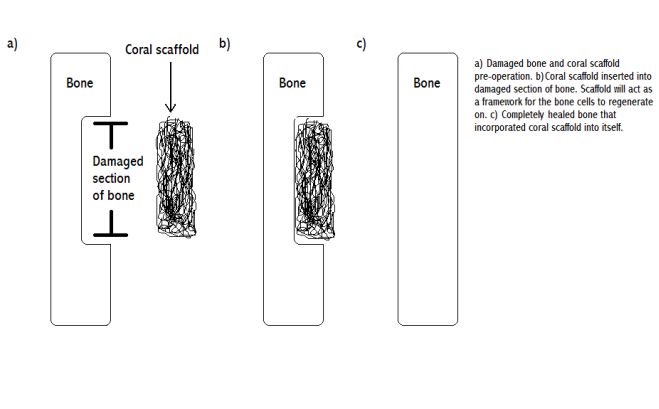

Introduction
In the modern medical world, bone tissue reparation is becoming an increasingly feasible process. The technique most commonly used for this operation is a bone graft[1], where surgeons place existing, gathered bone mass from another source and graft it to the section of bone being repaired. However, it is very difficult to amass the amount of bone necessary for such an operation.[1] Fortunately, a new method of repairing bone damage has emerged.
New Frontiers
Through biomimicry, researchers have developed a novel method of repairing bone structure using coral and marine sponges as scaffolds, or frames for bone tissue to regenerate onto.[2] These materials prove ideal for this type of operation because they are easily integrated into existing bone structure and greatly resemble bones in terms of porosity and composition (all are similarly constructed with calcium carbonate).[1],[3]
The Process
In order to repair bone tissue using these methods, surgeons must prepare the coral or marine sponge scaffolds. The scaffold is crafted to form-fit the area desired to be repaired.[1] They must also prepare substances such as marrow stromal cells (MSC)[1] or stem cells (cells capable of becoming any other cell within the body).[3] During the operation the scaffold and cells are inserted into the damaged bone section (Fig. 1). Over time, bone tissue either expands from the existing bone onto the scaffold[1] or stem cells are converted into bone cells directly on the scaffold[3], depending on whether MSC or stem cells were implanted with the scaffold. As the bone heals, the coral or marine sponge scaffold is integrated into the bone structure; that is, they become part of the bone.[1],[3] This becomes possible because of the similarities between bone and coral/marine sponges already stated. By the end of the recovery period, the scaffold area has effectively become identical to the rest of the bone (Fig 1).[1]

Figure 1
The Advantages
Typical implants for this procedure, usually ceramics or alloys, prevent stress on the bone structure they are grafted to, a process known as stress-shielding. In this process, the much stronger metals or ceramics absorb all of the stress applied to the bone. This prevents bone, which uses stress as an indication to produce more bone cells, from healing and growing properly, causing the bone to atrophy and possibly die.[4] Coral and marine sponges, on the other hand, are not stronger than bone, and simply provide the framework for the bone cells to build around. They avoid the problem of stress-shielding.[4]
Conclusion
In conclusion, repairing bone tissue with the use of coral and marine sponges represents an immense breakthrough, made possible through biomimetics, that has revolutionized bone surgery.